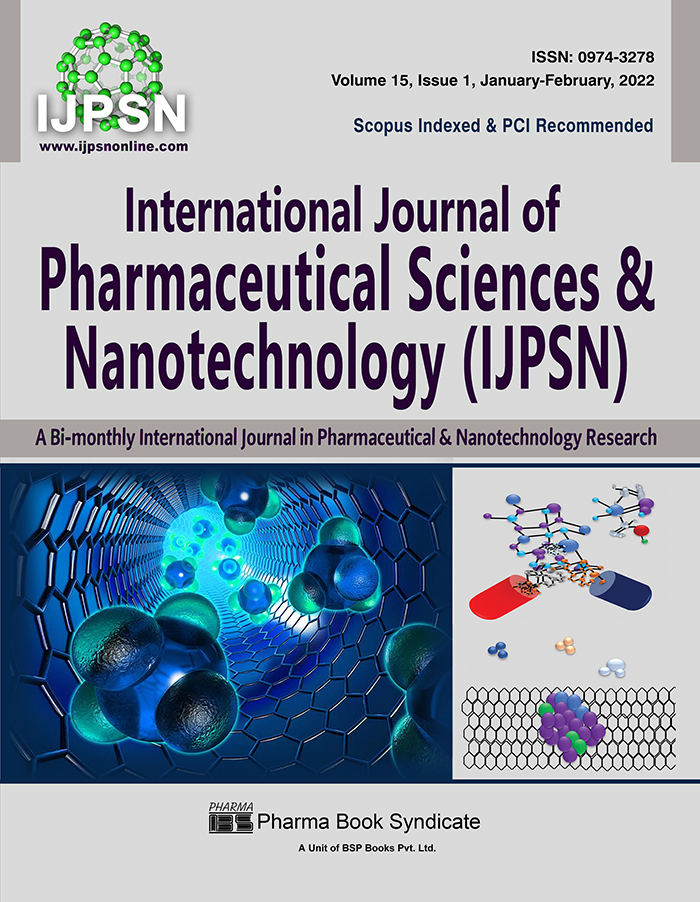Effect of Capecitabine Resealed Erythrocytes on MNU Induced Hepatocarcinogenesis in Swiss Albino Mice
DOI:
https://doi.org/10.37285/ijpsn.2022.15.1.9Abstract
Rationale of the study: Capecitabine is potential anticancer prodrug approved for colorectal cancer and metastatic breast cancer. It has short half life and several adverse effects due to which was encapsulated in erythrocytes for the treatment of hepatocellular carcinoma to observe and compare the effect of formulation with that of plain drug.
Introduction: The hepatoprotective potential of Capecitabine resealed erythrocytes was evaluated using MNU induced hepatocarcinogenesis in swiss albino mice model of 4 weeks.
Methodology: In present study, the effects of formulation and plain drug with respect to body weight, haematological parameters, biochemical parameters and histopathological study were evaluated and compared.
Results: Formulation restored the normal body weight and liver architecture with slight differences. Except platelets and neutrophils, no significant differences were observed in haematological parameters. The values of antioxidant enzymes (SOD, Catalase) and AFP were also restored more with formulation than plain drug though with no statistical differences when compared with normal control. Also it reduced the lipid peroxidation in the liver in treated group Vs induced group.
Conclusion: All these findings demonstrated hepatoprotective and anticancer effect of Capecitabine Resealed Erythrocytes (CRE) and suggested the use of this sustained release formulation in cancer chemoprevention.
Downloads
Metrics
Keywords:
MNU, hepatocarcinogenesis, antioxidant, AFP, haematological, Capecitabine resealed erythrocytesDownloads
Published
How to Cite
Issue
Section
References
Chedid MF, Kruel RP, Pinto MA, Tomaz JM, Filho G, Leipnitz I, Krue DP, Leandro A. Scaffaro E and Chedid AD (2017). Hepatocellular Carcinoma: Diagnosis and Operative Management. Arq Bras Cir Dig 30(4): 272-278.
Dara KK, Alib S, Ejazc M, Nasreenc S, Ashrafc N, Gillanic SF, Shafic N, Safeerc S, Khanc MA, Andleebc S and Mughal TA (2019). In vivo induction of hepatocellular carcinoma by diethylnitrosoamine and pharmacological intervention in Balb C mice using Bergenia ciliata extracts. Braz J Biol :1-10.
Dean SW, Brooks TM, Burlinson B, Mirsalis J, Myhr B, Recio L and Thybaud V (1999) Transgenic mouse mutation assay systems can play an important role in regulatory mutagenicity testing in vivo for the detection of site-of-contact mutagens, Mutagenesis 14(1):141–151.
Franchi CA, Bacchi MM and Padovani CR (2003). Thymic lymphomas in Wistar rats exposed to N-methyl-N nitrosourea (MNU). Cancer Sci 94(3): 240-43.
Gnanaraja R (2014). Preventive Effect of Tephrosia Purpurea Against N, N-Diethylnitrosamine Induced Hepatocellular Carcinoma In Swiss Albino Mice. J Biol Life Sci 5(2): 1-9.
Kandimalla R, Das M, Bhattacharjee S, Choudhury P, Devi R, Talukdar NC, Samanta SK (2021). Effect of multiple doses of N-methyl-N-nitrosourea, an end product of methylguanidine (found in processed food), on the fertility of female Swiss albino mice. Heliyon 7 e06738: 1-
Latha S, Selvamani P, Naveenkumar K, Ayyanar P, Silambarasi T (2012). Formulation and Evaluation of Capecitabine Nanoparticles for Cancer Therapy. Int J Biol Pharm Res 3(3): 477-487.
Liu Y, Yin T, Feng Y, Cona MM, Huang G, Liu J, Song S, Jiang Y, Xia Q, Swinnen JV, Bormans G, Himmelreich U, Oyen R and Ni Y (2015). Mammalian models of chemically induced primary malignancies exploitable for imaging
based preclinical theragnostic research. Quant Imaging Med Surg 5(5):708-729.
Moon RC, Kelloff GF, Detrisac CJ, Steele VE, Thomas CF and Sigman CC (1992). Chemoprevention of MNU-induced mammary tumours in the mature rat by 4-HPR and tamoxifen. Anticancer Res 12: 1147-1153.
Nofal AE, Shatla IM, Abdelhafeez DA, Mustafa M, Aly OM (2021). OMA1520 and OMA1774, novel 1,2,4-triazole bearing analogs of combretastatin A-4, inhibit hepatocellular carcinoma: Histological and immunohistochemical studies. Biomed. Pharmacother 138: 1-13.
Osowole AA, Oni AA, Onadje FO, Onyegbula KC and Hassan AT (2013). Effects of Injected N-methyl-N nitrosourea (MNU) in Albino Mice on the Histology and Haematology of Selected Organs of the Circulatory, Lymphoid and Digestive Systems. Br J Appl Sci Technol 3(1): 17-33.
Osowole AA, Oni AA, Onadje FO, Onyegbula KC and Hassan AT (2016). The Antitumor Properties of a Metal
free Ligand and Local Herbal Remedy against N-methyl N-nitrosourea (MNU)-induced Carcinomas in Albino Mice. Br J Pharm Res 10(1): 1-17.
Rivera ES, Andrade N, Martin G, Melito G, Cricco G, Mohamad N (1994). Induction of mammary tumors in rat by intraperitoneal injection of MNU: histopathology and estral cycle influence. Cancer Lett 86 :223-28.
Samaras V, Rafailidis PI, Mourtzoukou EG, Peppas G and Falagas ME (2010). Chronic bacterial and parasitic infections and cancer: a review. J Infect Dev Ctries 4: 267– 81.
Singh D, Singh M, Yadav E, Falls N, Komal U, Dangi DS, Kumare V and Verma A (2018). Amelioration of diethylnitrosamine (DEN)-induced hepatocellular carcinogenesis in animal models via knockdown oxidative stress and proinflammatory markers by Madhuca longifolia embedded silver nanoparticles. RSC Advances 8, 6940-6953.
Somanah J, Ramsaha S, Verma S, Kumar A, Sharma P, Singhe RK, Aruoma K, Bourdon E and Bahorun T (2016). Fermented papaya preparation modulates the progression of N-methyl-N-nitrosourea induced hepatocellular carcinoma in Balb/c mice. Life Sci 151: 330–338.
Thompson HJ, McGinley JN, Rothhammer K and Singh M (1995). Rapid induction of mammary intraductal proliferations, ductal carcinoma in situ and carcinomas by the injection of sexually immature female rats with 1-
methyl-1-nitrosourea. Carcinogenesis 16: 2407-411. 18. Verma S, Bahorun T, Singh RK, Aruoma OI & Kumar A (2013). Effect of Aegle marmelos leaf extract on N-methyl N-nitrosourea-induced hepatocarcinogensis in Balb/c mice. Pharm Biol 51(10): 1272–1281.
Waghray A, Murali AR and Menon KVN (2015). Hepatocellular carcinoma: From diagnosis to treatment. World J. Hepatol. 8: 1020-1029.
Webera A, Boegeb Y, Reisingerc F and Heikenwalderb M (2011). Chronic liver inflammation and HCC: persistence matters. Eur. J. Med. Res 141; w13197: 1-9.






